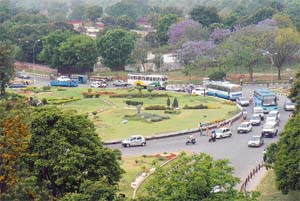|
good motoring
Redesign
roundabouts
H. Kishie Singh
 Some
time ago there was talk of removing roundabouts and installing
traffic lights in Chandigarh. Then there was talk of restoring
traffic lights where roundabouts had been removed. This
flip-flop talk points to one thing. No one in authority — the
administration, the Engineering Department or the police —
knows what traffic management is all about. They continue to
control traffic as they did half a century ago, even though
traffic has increased multifold. Madhya Marg was never designed
to carry the heavy traffic it does today. This applies to
vehicular traffic, motorised as well as non-motorised, and
pedestrian traffic as well. Some
time ago there was talk of removing roundabouts and installing
traffic lights in Chandigarh. Then there was talk of restoring
traffic lights where roundabouts had been removed. This
flip-flop talk points to one thing. No one in authority — the
administration, the Engineering Department or the police —
knows what traffic management is all about. They continue to
control traffic as they did half a century ago, even though
traffic has increased multifold. Madhya Marg was never designed
to carry the heavy traffic it does today. This applies to
vehicular traffic, motorised as well as non-motorised, and
pedestrian traffic as well.
The vehicles that
once drove on the majestic city roads were a motley collection
of Ambassadors and Padminis and possibly a few other antiques.
The distance between the roundabout is a consistent 700-750
metres and these cars moved at a stately 40 kmph —maybe 45
kmph — if the cars had a tailwind. Very important, the drivers’
attention was focused on their driving as these cars had to be
coaxed along. There were no radios and music systems putting out
a thousand watts of music power to distract the driver. No
airconditioning to cocoon the driver into a somnambulant state.
Fifty metres before the roundabout the driver readied himself to
wrestle with the steering`85 there was no hydraulic or
electronic power to the steering, only human power. All this
made for demanding driving and, consequently, safe driving.
In a 700-metre
stretch, the top speed seldom exceeded 45-50 kmph. Even if you
ran head on into a roundabout at that speed the damage would be
minimal. Sure, the car would be damaged, as would the roundabout
but the driver and passengers would be comparatively unharmed.
So a quarter of a
century ago, the concrete roundabouts served a purpose as most
vehicles didn’t go beyond 45 kmph. Along came the Maruti 800
and soon Indian drivers had mastered all the bad habits of
driving, jumping red lights, overtaking from the left and
zooming up to 75 kmph and more in short bursts of speed. Every
successive car to enter the market was bigger and faster and
running into roundabouts became a routine affair.
Drivers killed
themselves, their passengers and damaged the roundabout.
In a complete
lackadaisical attitude the roundabout was repaired and not a
thought was given to prevention of accidents. Little wonder that
one person is killed on our city roads every second day. The
babus’ job was simply to repair the roundabout. Lives lost was
of no concern.
The roundabouts
are necessary for traffic management but the design is flawed.
They have a solid concrete wall, about one-metre high with
thousands of tonnes of mud behind it. This solid wall could stop
a bulldozer. Over the years these roundabouts have stopped
hundreds of cars and claimed many lives. The authorities could
not learn a lesson from Delhi’s roundabouts.
Even if a car
failed to negotiate and hit the post holding the cable in Delhi’s
roundabouts, it will cause minimal damage. Running into the
cable would restrain the car, gently. If the car got past the
cable, the flowerbeds and the lawn would bring the car to a
halt. A flowerbed is soft mud and will grab a car’s wheels and
hold it. The car would not be smashed or flipped into the air.
The occupants could get battered and bruised but in all
likelihood there would be no fatalities.
A little bit of
thought can change the traffic scenario in Chandigarh. We can
retain the roundabouts, some of which are Chandigarh’s most
beautiful gardens, manage traffic and save lives at the same
time.
Happy motoring.

|